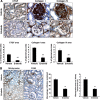Epidermal growth factor receptor inhibition slows progression of diabetic nephropathy in association with a decrease in endoplasmic reticulum stress and an increase in autophagy
- PMID: 24705402
- PMCID: PMC4030104
- DOI: 10.2337/db13-1279
Epidermal growth factor receptor inhibition slows progression of diabetic nephropathy in association with a decrease in endoplasmic reticulum stress and an increase in autophagy
Abstract
Previous studies by us and others have reported renal epidermal growth factor receptors (EGFRs) are activated in models of diabetic nephropathy. In the present study, we examined the effect of treatment with erlotinib, an inhibitor of EGFR tyrosine kinase activity, on the progression of diabetic nephropathy in a type 1 diabetic mouse model. Inhibition of renal EGFR activation by erlotinib was confirmed by decreased phosphorylation of EGFR and extracellular signal-related kinase 1/2. Increased albumin/creatinine ratio in diabetic mice was markedly attenuated by erlotinib treatment. Erlotinib-treated animals had less histological glomerular injury as well as decreased renal expression of connective tissue growth factor and collagens I and IV. Autophagy plays an important role in the pathophysiology of diabetes mellitus, and impaired autophagy may lead to increased endoplasmic reticulum (ER) stress and subsequent tissue injury. In diabetic mice, erlotinib-treated mice had evidence of increased renal autophagy, as indicated by altered expression and activity of ATG12, beclin, p62, and LC3A II, hallmarks of autophagy, and had decreased ER stress, as indicated by decreased expression of C/EBP homologous protein, binding immunoglobulin protein, and protein kinase RNA-like ER kinase. The mammalian target of rapamycin (mTOR) pathway, a key factor in the development of diabetic nephropathy and an inhibitor of autophagy, is inhibited by AMP-activated protein kinase (AMPK) activation. Erlotinib-treated mice had activated AMPK and inhibition of the mTOR pathway, as evidenced by decreased phosphorylation of raptor and mTOR and the downstream targets S6 kinase and eukaryotic initiation factor 4B. Erlotinib also led to AMPK-dependent phosphorylation of Ulk1, an initiator of mammalian autophagy. These studies demonstrate that inhibition of EGFR with erlotinib attenuates the development of diabetic nephropathy in type 1 diabetes, which is mediated at least in part by inhibition of mTOR and activation of AMPK, with increased autophagy and inhibition of ER stress.
© 2014 by the American Diabetes Association.
Figures







References
-
- Kanwar YS, Wada J, Sun L, et al. Diabetic nephropathy: mechanisms of renal disease progression. Exp Biol Med (Maywood) 2008;233:4–11 - PubMed
Publication types
MeSH terms
Substances
Grants and funding
LinkOut - more resources
Full Text Sources
Other Literature Sources
Medical
Molecular Biology Databases
Research Materials
Miscellaneous

